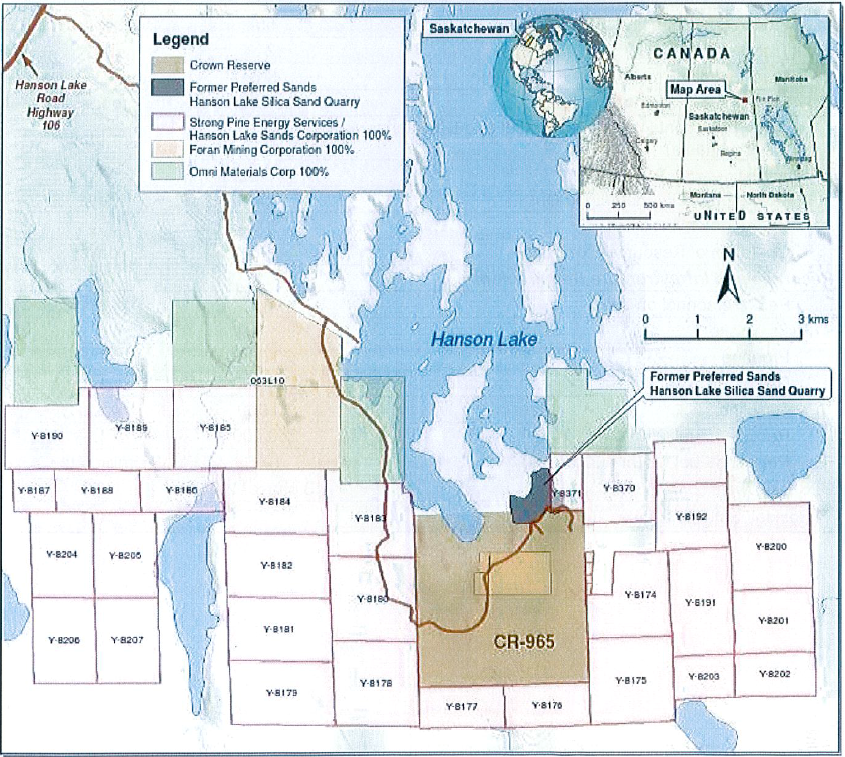Strong Pine Energy is nearing the next step to finalize the creation of a silica mine near Hanson Lake. The company’s proposal and environmental impact statement is on display at the Village of Denare Beach and Town of Creighton community offices and Peter Ballantyne Cree Nation (PBCN) band halls. The package of statements contains over 1,000 pages of data, site research, notes from consultations and the company’s environmental plan for a possible mine in the form of three large three-ring binders.
The environmental impact statement shows Strong Pine plans for 25 years of mining, although the company has said in community meetings the mine could be active for up to 40 years, producing 2.5 million tonnes of silica sand per year.
Silica sand is a refined, pure quartz sand often used in fracking for natural gas and oil extraction. A former silica mine ran by Preferred Sands Canada is located within kilometres of the proposed site. Strong Pine called the previous mine “patchwork” in their submission, stating the mine supplied 25 per cent of the silica sand used in western Canada at one point. In the publicly available documents, executives with the company stressed the new mine would be forward thinking in its approach.
In their submission, Strong Pine representatives said the mine could create 300 jobs, split 60/40 between the mine and a yet-to-be-built distribution centre in Flin Flon.
If the environmental plan is approved, the next step for Strong Pine would be to secure funding. When asked at a meeting if PBCN would be investing in the project, Strong Pine CEO Kyle Holmes was quoted in the report as saying that would not likely be in the cards, but stressed the company would attempt to hire locally as much as possible for the mine.
The statement describes the basic on-site operation as blasting out sand, piping it to a nearby processing plant and drying it before shipping it by truck to Flin Flon, where it would be distributed to consumers by train.
In the statement, Strong Pine representatives said they planned to use progressive reclamation during the project to minimize the impact on the environment. They estimated the project, if approved, built and operated, would require 670 hectares of forest and 922 hectares of various wetlands to be cleared over 25 years. The plan calls for vegetation clearing to take place during the winter months to minimize environmental impact, only clearing 60 hectares at a time. Permanent facilities would be built on higher ground to avoid affecting wetlands.
The water used to process the sand would be treated on-site and, according to the environmental plan, would be discharged into Hanson Lake after treatment. The company would conduct regular testing to ensure there is no contamination. The mine plan would also require dewatering wells to prevent groundwater flow into the mining operations. The dewatering wells are important to move the water table below the blasting zone. Mitigation measures are outlined in the plan if something were to go wrong, including treating ground water through reverse osmosis to prevent any disaster.
Each of the potential effects and Strong Pine’s mitigation techniques are detailed in their submissions.
The three binders at local government offices represent the second attempt from Strong Pine to get approval for a silica sand mine. A letter of support from the Regional Economic Development Commission (REDC) is included in the submission, signed by Flin Flon Mayor Cal Huntley, Creighton Mayor Bruce Fidler and Denare Beach Mayor Carl Lentowicz in July 2018.
At the Jan. 8 meeting of Creighton town council, Fidler said the company had been in discussion with the community.
“We’ve had discussions with and numerous meetings with Strong Pine, probably for the past year. We’ve been in constant contact with them. We’re aware of everything they’ve been doing and what their plan is,” he said.
Strong Pine’s first attempt at getting a mine plan approved was made in 2014. That plan was sent back by the Saskatchewan government due to deficiencies. The main deficiency identified was a lack of consultation with PBCN and Métis communities who could be affected by the mine. According to their submission, Strong Pine held three open houses in 2014 and held seven open houses early in 2019.
Reactions to the project are detailed in the company’s proposed plan. Responses in the application were mostly positive, focusing on potential jobs that a new mine site could create.
The company was notified plans for a mine would have to expand on a caribou protection plan and detail how Strong Pine would deal with the risk of increased traffic on the roads leading to and from the mine, including the gravel road currently running to the site and on Highway 106.
Strong Pine Energy is not connected to Foran Mining, who are expected to release a feasibility study for a potential copper/zinc mine at McIlvenna Bay, also located on the south shore of Hanson Lake, later this year.
Representatives from Strong Pine did not respond to repeated requests for comment on the Hanson Lake project from The Reminder.
The final deadline for written comments is Feb. 3. Comments can be emailed to [email protected].
-
with files from Eric Westhaver




